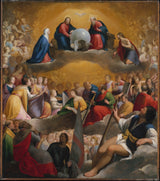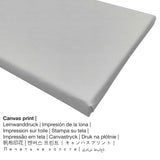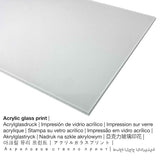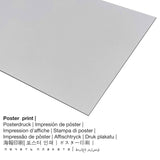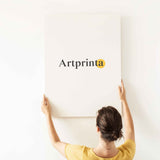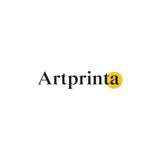Carlo Saraceni, 1598 - Paradaịs - mbipụta nka mara mma
Ụtụ gụnyere. Mbupu gbakọrọ na ndenye ọpụpụ.
Akụrụngwa ị nwere ike ịhọrọ
In the product dropdown lists you can choose the size and materialaccording to your preferences. Hence, we allow you to choose among the following options:
- Kwaaji: The printed canvas, which shall not be mistaken with a painting on a canvas, is a digital replica applied onto canvas. A canvas print has the advantage of being low in weight, which implies that it is easy to hang up the Canvas print without additional wall-mounts. That is why, a canvas print is suitable for all types of walls.
- Akwụkwọ mmado na ihe kwaaji: A poster is a printed canvas paper with a granular texture on the surface. It is optimally appropriate for putting the art copy with the help of a customized frame. Please bear in mind, that depending on the size of the poster we add a white margin of something between 2-6 cm around the print, which facilitates the framing.
- Mbipụta enyo acrylic: The acrylic glass print, which is often referenced as a print on plexiglass, changes an original into décor. With an acrylic glass fine art print contrasts and granular details will be more recognizeable with the help of the very fine gradation.
- Aluminom ihe eji eme ihe: This is a metal print made on aluminium dibond with an outstanding depth effect. A non-reflective surface make a fashionable impression. The Direct Print on Aluminum Dibond is the perfect start to art reproductions on aluminum. The bright and white sections of the work of art shine with a silky gloss but without any glow. The colors of the print are luminous and vivid in the highest definition, details are crisp. The direct UV print on Aluminum Dibond is one of the most demanded entry-level products and is a modern way to display fine art prints, since it puts all of the viewer’s attention on the whole artwork.
Legal note: We do our best to describe our products as precisely as possible and to display them visually in our shop. Nevertheless, the pigments of the printed materials and the printing might vary to a certain extent from the representation on the device's screen. Depending on the screen settings and the nature of the surface, colors might not be printed one hundret percent realistically. In view of the fact that the are printed and processed by hand, there may also be slight differences in the size and exact position of the motif.
Nkọwa ihe osise izizi sitere na The Metropolitan Museum of Art (© - nke Ụlọ ihe ngosi nka nke Obodo ukwu - Museumlọ ihe ngosi nka nke Obodo)
In this scene, representing Paradise, Christ and God the Father are above, surrounded by the symbols of the Evangelists and flanked by the Virgin and Saint John the Baptist. The foreground figures represent (left) the Doctors of the Church, (center) Saint George, and (right) Saint Christopher. It is likely that the man looking out from bottom left may be a portrait of the original (unidentified) patron. Saraceni left Venice for Rome in 1598, and this picture, which is based on an altarpiece by Francesco Bassano in the church of the Gesù, was painted about this time.
In 1598 Carlo Saraceni painted the baroque piece of art. The 420 year old version of the painting was made with the absolute size - N'ozuzu 21 3/8 x 18 7/8 na (54,3 x 47,9 cm); elu agba 20 7/8 x 18 3/8 inch (53 x 46,7 cm). Mmanụ na ọla kọpa was used by the Italian painter as the technique for the masterpiece. The piece of art belongs to the digital collection of The Metropolitan Museum of Art. This ngalaba ọha masterpiece is being provided with courtesy of The Metropolitan Museum of Art, New York, Theodore M. Davis Collection, Bequest of Theodore M. Davis, by exchange, 1971. The creditline of the artpiece is the following: Theodore M. Davis Collection, Bequest of Theodore M. Davis, by exchange, 1971. Na mgbakwunye na nke ahụ, nhazi ahụ bụ Eserese ya na oke nke 1: 1.2, nke pụtara na ogologo bụ 20% mkpụmkpụ karịa obosara. Carlo Saraceni was a male painter from Italy, whose artistic style can be classified as Baroque. The artist lived for 41 afọ a mụrụ na 1579 in Venice, Venezia province, Veneto, Italy and died in the year 1620 in Venice, Venezia province, Veneto, Italy.
Nkọwa ahaziri nke mpempe nka
| Aha nke ihe nka: | "Paradise" |
| Nhazi nka: | sere |
| Okwu mkpokọta: | nka ochie |
| Time: | 16th narị afọ |
| Ekepụtara: | 1598 |
| Afọ nka: | gbara afọ 420 |
| Ọkara nke ihe osise izizi: | mmanụ na ọla kọpa |
| Nha izizi: | N'ozuzu 21 3/8 x 18 7/8 na (54,3 x 47,9 cm); elu agba 20 7/8 x 18 3/8 inch (53 x 46,7 cm) |
| Ụlọ ihe ngosi nka: | Museumlọ ihe ngosi nka nke Obodo |
| Ebe ngosi nka: | New York City, New York, Njikota Obodo Amerika |
| Ebe nrụọrụ weebụ ihe ngosi nka: | www.metmuseum.org |
| Ikikere nke ihe osise: | ngalaba ọha |
| Site n'aka: | The Metropolitan Museum of Art, New York, Theodore M. Davis Collection, Bequest of Theodore M. Davis, by exchange, 1971 |
| Ebe kredit nke ọrụ nka: | Theodore M. Davis Collection, Bequest of Theodore M. Davis, by exchange, 1971 |
Nkọwa ngwaahịa ahaziri ahazi
| Ụdị edemede: | ọrụ mgbidi |
| Mmeputakwa: | dijitalụ mmeputakwa |
| Usoro mmepụta: | Mbipụta UV / dijitalụ |
| Mmalite ngwaahịa: | arụpụtara na Germany |
| Ụdị ngwaahịa: | na mmepụta ihe |
| Ngwaahịa were: | art mmeputakwa gallery, mgbidi mma |
| Nhazi: | usoro eserese |
| Oke akụkụ: | 1: 1.2 - ( Ogologo: obosara) |
| Ntụgharị nkọwa akụkụ: | ogologo bụ 20% mkpụmkpụ karịa obosara |
| Ihe mmeputakwa dị: | acrylic glass print (nwere ezigbo mkpuchi iko), mbipụta akwụkwọ mmado (akwụkwọ kwaaji), mbipụta ọla (aluminium dibond), mbipụta akwụkwọ. |
| Nhọrọ nha nha mbipụta kanvas (akwa akwa na etiti ihe ndọtị): | 50x60cm - 20x24", 100x120cm - 39x47", 150x180cm - 59x71" |
| Mpempe iko acrylic (nwere ezigbo mkpuchi iko) nha: | 50x60cm - 20x24", 100x120cm - 39x47" |
| Mpempe akwụkwọ mmado (akwụkwọ kwaaji) nha dị iche iche: | 50x60cm - 20x24", 100x120cm - 39x47" |
| Nhọrọ nha mbipụta aluminium dibond: | 50x60cm - 20x24", 100x120cm - 39x47" |
| Nhazi mbipụta nka: | biko buru n'uche na ngwaahịa a enweghi etiti |
Nchịkọta ihe nkiri
| Ihe nkiri: | Carlo Saraceni |
| Aha nka ndị ọzọ: | Carlo Saraceni, Veneziano Carlo, Carlo Saraceno Venetiano, Carlo Saracino, C. Venetiano, Carlo Saraccino, Carlo Sarazzano, Saraceni Carlo Veneziano, saracino carlo, Carlo Venetiano, Carlo Venetiani, Carolus Sarasennus Venetiano, Carlo Veneziano, Carlos beneçiano, carlo saraceni gen. Veneziano, carlo saraceno, Saraceni Carlo, Carlo Saracino detto il veneziano, Car. Saracenus, Saraceni, carlo saraceni gen. veneziano |
| okike nke onye nka: | nwoke |
| Obodo onye nka: | Italian |
| Ọrụ: | onye na-ese ihe |
| Country: | Italy |
| nhazi ọkwa: | nna ukwu ochie |
| Ụdị nke onye na-ese ihe: | Baroque |
| Afọ ọnwụ: | 41 afọ |
| A mụrụ: | 1579 |
| Amụrụ na (ebe): | Venice, mpaghara Venezia, Veneto, Italy |
| Nwuru: | 1620 |
| Nwuru na (ebe): | Venice, mpaghara Venezia, Veneto, Italy |
Edochiri ederede a site na nwebiisinka © | www.artprinta.com (Artprinta)

